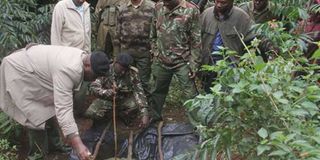Crackdown, sacking of chiefs drives Central Kenya illicit liquor dens to forests

Police inspect an illicit liquor “brewery” during a crackdown along Muringato River in Kiganjo, Nyeri County on June 24, 2016. Makers of illegal alcohol have moved their dens to forests as the war against the illegal business intensifies. PHOTO | NICHOLAS KOMU | NATION MEDIA GROUP
What you need to know:
- Previously, they would make the killer brews or spirits in slums near rivers using makeshift distilleries.
- In Nyeri, the woodland along Muringato River has provided a perfect cover for the alcohol makers.
- The dense canopy prevents detection of smoke emitted by the distilleries.
- In the last two weeks, police officers and chiefs have impounded more than 5,000 litres of chang’aa and kangara.
Following an intense crackdown and sacking of chiefs suspected of laxity in the fight against illicit alcohol, the makers of the brews in Central Kenya are devising ways of evading the police by operating from forests.
As the war on illegal liquor intensifies, the makers have also devised manufacturing methods that ere not easily detected by police.
The methods also take a short time.
Previously, they would make the killer brews or spirits in slums near rivers using makeshift distilleries.
They would then bribe chiefs to look the other way.
But the noose on chiefs by the presidency and the Interior ministry has tightened.
Liquor makers have now set up makeshift structures deep inside various forests.
In Nyeri, the woodland along Muringato River has provided a perfect cover for the alcohol makers.
The dense canopy prevents detection of smoke emitted by the distilleries.
BREWERS KNOW TERRAIN WELL
The terrain also gives the culprits an advantage should the need to escape arise.
“These people know the terrain very well. That is how they manage to slip away,” county Administration Police Commander Njue Njagi said.
“In fact, no brewer has been arrested during such raids,” he added.
The brew makers now dig pits for easier fermentation of the alcohol.
The process also does away with the need to have fires, which can be seen from far.
It also eliminates the need for a large number of people visiting the area.
EQUIPMENT EASILY DESTROYED
“Equipment used to make the liquor is usually destroyed and that is why they have resorted to these tactics,” the AP boss said.
Distillation takes just one day.
Once the process is complete, the equipment are transported at night to be hidden elsewhere.
The finished product is also ferried at night to a distribution centre in Majengo slums.
Here, thousands of litres of chang’aa and other killer spirits and brews are sold, keeping the illegal business alive.
In the last two weeks, police officers and chiefs have impounded more than 5,000 litres of chang’aa and kangara.
However, nobody has been apprehended during the raids.




